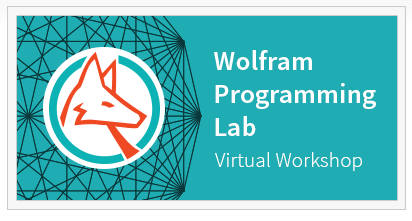Engaged Students, Happy Teachers with Wolfram Programming Lab
For the last few days, we’ve been discussing Wolfram Programming Lab and how it is a tool for those teachers looking to incorporate coding into their computational classrooms. Today is the last day of the series, and I’m going to talk about the experiences I’ve had with Programming Lab. What I’ve seen from numerous workshops is that adopting a computational thinking approach increases engagement and supports creativity in the classroom. Having an engaged classroom is paramount; otherwise, teachers risk students falling into a dangerous spiral of disinterest that prevents them from learning and is likely to cause classroom management problems. Programming Lab gives teachers the ammunition to fight boredom and create exciting lesson plans.
My colleague Ishwarya and I have been visiting elementary, middle, and high schools for the past couple of years to teach workshops of various lengths. It’s been such a help to have the Wolfram Language in the cloud. Without downloading any software, students are able to go to a website and start programming immediately. I usually start off my workshops with the Getting Started and Draw a Sphere Explorations. Here are some of the kids that I’ve worked with in the past year or so:

During one session I heard a girl say, “Look, look at what I just did—I created a sphere. And I made it green! This is awesome.”
I realized that not only were the students playing around and having fun coding, they were also able to create in the digital space. In kindergarten through second grade, most students are accustomed to drawing, cutting, pasting, and creating things to showcase their understanding. Programming in the Wolfram Language gives students an opportunity to create a whole host of useful things digitally. All the students could point to their code and feel proud of their creations, even if it was only calculating 123*456 or generating a purple cone.
Students are accustomed to using phones, tablets, and computers. It makes sense to give students the opportunity to create for this digital space. It’s what they’re interested in, and it’s what they care about. Students were given the freedom to play with the code and make it their own. Yes, there were tons of syntax errors, but they helped each other out, and Programming Lab even has a feature that lets them start off from the original code. Collaboration and genuine learning go through the roof when students are engaged.

When I give these workshops, the majority of the students have never programmed with a text-based language. If they have coded before, even at the high-school level, it was most likely with block-based programming. I guide students through the various Explorations, asking questions along the way to get them thinking about their programs. After going through one of the Explorations with a fourth-grade class, I heard the teacher say, “Now this is coding! Not just moving blocks around.”
I think one of the great things about teaching programming, especially at the elementary level, is that students have the same experience—practically none. My students were starting off at the same point; everyone felt successful straight out of the gate. The result was that when I called on various students, I could see that almost everyone was engaged and understood what was going on. It was amazing! And what’s more, those students that could type faster and grasped the concepts a little better were helping their peers.
I understand the difficulty for teachers to incorporate yet another thing into their classrooms, but introducing programming and computational thinking is an excellent way to engage all students. Teachers don’t need to struggle to force a programming activity to be engaging; programming is inherently interesting all by itself.
There are more resources out there to help teachers get started. A more structured approach to learning the language is An Elementary Introduction to the Wolfram Language, which is available online for interactive use in Programming Lab.

To get a sense of what students can create with the Wolfram Language, check out the Wolfram Demonstrations Project. It’s an open database of over 10,000 interactive knowledge apps that were all created using the Wolfram Language. We have had several online workshops that discuss incorporating computational thinking strategies into the classroom. All are recorded and available on demand here.
There is a Wolfram Programming Lab–specific online event on February 25. We’ll go over how to get started using Programming Lab, its built-in Explorations, and case studies from elementary schools and secondary classrooms, with plenty of time for Q&A. You can register here.
What: Introducing Wolfram Programming Lab: Virtual Workshop for Educators
When: February 25, 2016, 4–5pm EST
Where: Free online
Who: Anyone who’s interested—no coding experience needed!




I couldn’t agree more with the computational thinking approach in the classroom. I utilized this in a previous life with my training day job and it does make a difference.
As a teacher I can say this works 100% in the classroom. Wolfram is a easy bridge to get kids more involved in programming. Thanks!
In this day and age everyone should learn how to program. Any technology/process to facilitate it is always welcome.